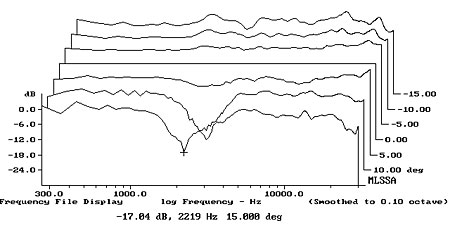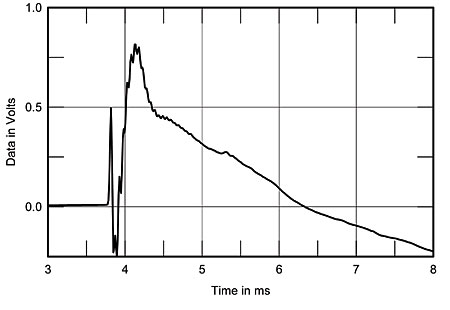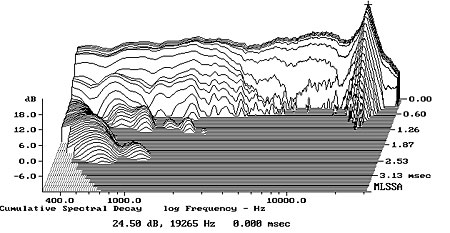| Columns Retired Columns & Blogs |
Monitor Audio Silver RS6 loudspeaker Measurements
Sidebar 3: Measurements
The Monitor Audio Silver RS6's estimated voltage sensitivity was 89.5dB(B)/2.83V/m, which, if slightly below the specified 91dB, is still higher than average. Its impedance (fig.1) remains above 6 ohms for almost the entire audioband, with a minimum value of 4.5 ohms at 165Hz. As well as being usefully sensitive, the RS6 is also an easy load for the amplifier to drive: textbook requirements for a speaker that will be used with inexpensive amplification. The small glitch at 20kHz in the impedance plots indicates that the metal-dome tweeter's "oil-can" resonance is a little lower in frequency than usual, and another glitch just below 300Hz implies the existence of some sort of panel resonance.

Fig.1 Monitor Audio Silver RS6, electrical impedance (solid) and phase (dashed). (2 ohms/vertical div.)
Investigating the vibrational behavior of the Silver RS6's enclosure with an accelerometer, I did indeed find a strong resonant mode at 290Hz on all surfaces (fig.2). However, as BJR didn't note any coloration in this region, I must assume that this behavior looks worse than it sounds.

Fig.2 Monitor Audio Silver RS6, cumulative spectral-decay plot calculated from the output of an accelerometer fastened to the cabinet's side panel 12" from the top (MLS driving voltage to speaker, 7.55V; measurement bandwidth, 2kHz).
The saddle centered on 42Hz in the fig.1 magnitude trace suggests that this is the tuning frequency of the twin ports; however, the additional bump in the low hundreds of hertz implies that the bass tuning is more complex than with a normal reflex design. The complicated overlay of colored traces to the left of fig.3 reveals what is going on. The blue trace shows the nearfield output of the midrange unit. Its response actually extends down to the upper bass, but with its rolloff below 120Hz broken by what appears to be a reflex notch at 105Hz. This happens when the cone is held motionless by the back pressure of the reflex port resonance, and indeed, the upper, rearward-facing port's output has a peak centered on the same frequency.

Fig.3 Monitor Audio Silver RS6, anechoic response on tweeter axis at 50", averaged across 30° horizontal window and corrected for microphone response, with the nearfield responses of the midrange unit (blue), woofer (red), upper, rear port (magenta), and lower, front port (green).
The RS6's woofer (red trace) covers a quite narrow, two-octave bandpass of 50–200Hz, and has a less-well-defined reflex notch—as does the midrange unit—at 42Hz, the frequency expected from the impedance plot. However, the front port (green) peaks a little higher in frequency, covering the 40–125Hz range. This port has some upper-frequency hash present in its output, but this is probably sufficiently well suppressed not to be an issue.
Normally, when I encounter such a complicated bass alignment, I have found it to offer very little performance benefit, if any, compared to a simpler reflex or sealed-box design. However, in the case of the Silver RS6, the result does appear to be, as BJR found in his auditioning, an effective combination of bass extension, definition, and sensitivity. This is shown by the black trace below 300Hz in fig.3, which is the sum of all the individual nearfield outputs, weighted in the ratio of their radiating diameters, and taking into account their acoustic phase and differences in nominal distance from a farfield point. The apparent rise in the midbass is almost entirely due to the nearfield measurement technique; the Silver RS6 is actually maximally flat down to almost 40Hz.
To the right of fig.3 is shown the Silver RS6's farfield response, averaged across a 30° horizontal window on the tweeter axis. The most prominent feature is the 15dB-high peak just below 20kHz. As I noted earlier, this is lower in frequency than usual, and some young listeners will be aware of its presence. Below the top octave, the RS6 slopes up gently from 300Hz to 11kHz. When unaccompanied by resonant problems, this sort of response gives the impression of articulation detail and space rather than brightness per se, which ties in with BJR's auditioning comments.
Fig.4 shows the RS6's lateral radiation pattern, with each off-axis trace normalized to the on-axis behavior so that just the changes can be seen. The dispersion narrows a little at the top of the midrange unit's passband, but the audibility of the corresponding flare in the radiation pattern at the bottom of the tweeter's passband will be ameliorated in a typical room by the broad depression in the same frequency region in the on-axis response seen in fig.3. Note that the tweeter also has wider-than-usual dispersion in the top octave. In the vertical plane (fig.5), a large suckout develops for listeners sitting more than 5° below the tweeter axis. However, the evenness of the tweeter-axis response is maintained well above that axis.

Fig.4 Monitor Audio Silver RS6, lateral response family at 50", normalized to response on tweeter axis, from back to front: differences in response 90–5° off axis, reference response, differences in response 5–90° off axis.

Fig.5 Monitor Audio Silver RS6, vertical response family at 50", normalized to response on tweeter axis, from back to front: differences in response 15–5° above axis, reference response, differences in response 5–15° below axis.
Turning to the time domain, the RS6's step response (fig.6) demonstrates that all three drive-units are connected in positive acoustic polarity. The farfield cumulative spectral-decay plot (fig.7) is impressively clean throughout the midrange and treble, marred only by the tweeter's oil-can resonance.

Fig.6 Monitor Audio Silver RS6, step response on tweeter axis at 50" (5ms time window, 30kHz bandwidth).

Fig.7 Monitor Audio Silver RS6, cumulative spectral-decay plot at 50" (0.15ms risetime).
Overall, this is impressive measured performance from a relatively inexpensive tower loudspeaker.—John Atkinson
- Log in or register to post comments




































